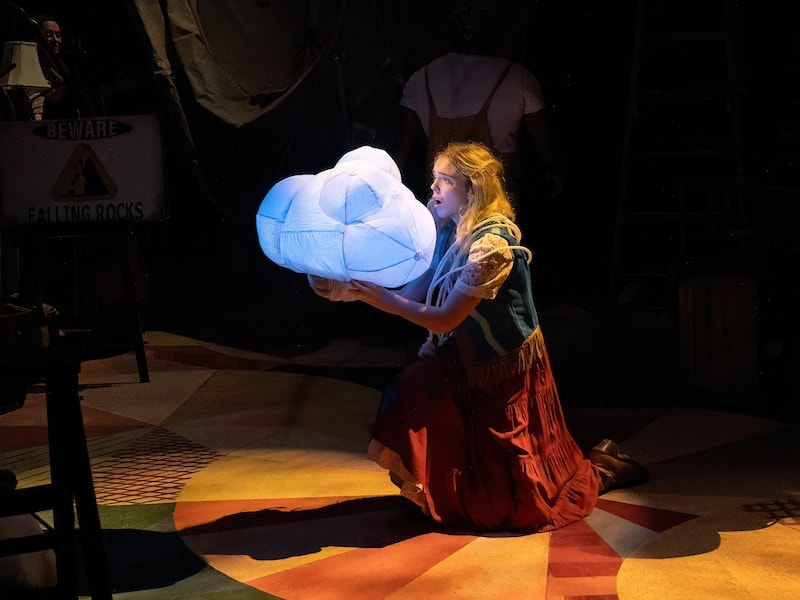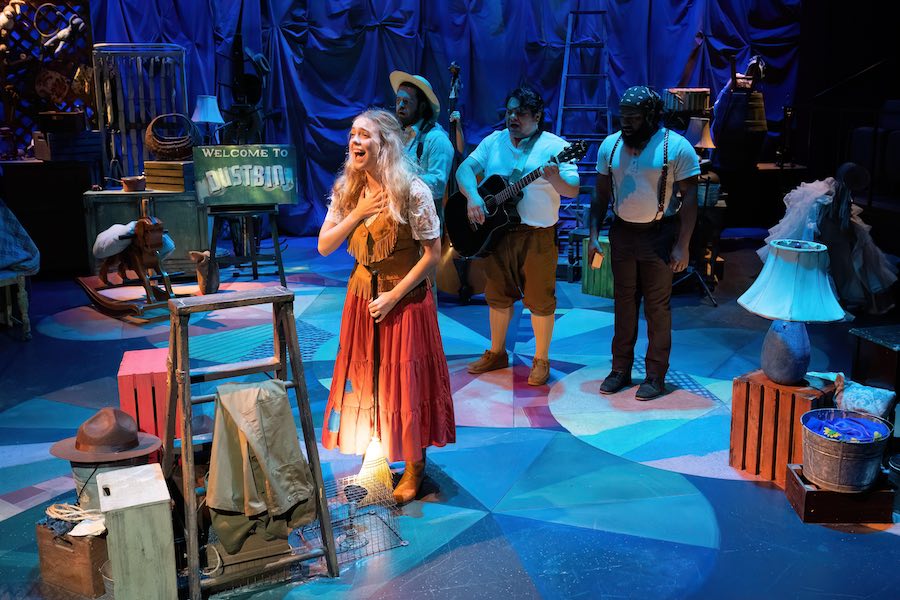By Jillian Parks
In a world of iPad kids and enough one-dimensional children’s entertainment to sedate them, The Girl Who Became Legend is a folksy, textured, warm theatrical experience that prioritizes kids having the space to be kids in every facet of the show.
The Girl Who Became Legend, directed by Liz Fisher, follows a young girl named Raina, played by Blakeney Mahlstedt, living in a dusty town stricken by drought, fittingly called Dustbin. The mayor, played by Helyn Rain Messenger, makes and enforces two major rules in the town: nobody has access to enough water (but him), and stories are outlawed. When Raina spots a rain cloud, she tries to tell everyone the good news, but the hopeless townspeople and the mayor himself call her a liar and punish her mother, played by Amber Quick, for playing into Raina’s “delusions.” To prove she’s not a liar and to save her mother from her empty-well prison cell, Raina goes out into the Great Wild Unknown to chase the cloud.

The show premiered with the same cast at ZACH Theatre in Austin, Texas, before making its way up to Washington, DC, as a co-commission and co-production with the Kennedy Center. Sarah Saltwick wrote the script and lyrics, and Messenger, Quick, and Paul Sanchez composed the music and contributed additional lyrics.
The Greek chorus style of the ensemble features five actors who play multiple roles, and all of the ensemble members — Quick, Sanchez, Rain Messenger, Jeremy Rashad Brown, and Nathan Daniel Ford — contribute musically as well as dramatically. A banjo, cello, fiddle, guitar, tambourine, and rainstick make frequent appearances as actors guide the audience through the journey they create.
The songs were not as memorable as the live aspect of the music and were most effective in conveying the folk-style setting of the work. The breadth of talent that each actor/musician displayed was indispensable to the magical quality of the show. Live music has that quality, and integrating the magic of children’s stories with the magic of live music was a genius move on behalf of the creative team.“Welcome to Dustbin,” the opening song, is the catchiest tune I remember, but the songs, in general, seemed to function alone in service of telling the story, rather than standing alone as big production numbers.
The set, lighting, and costuming (by Lisa Laratta, Rachel Atkinson, and Aaron Flynn, respectively) also greatly contribute to this magic. The set features the kind of junk someone might find in a garage or an attic but is used effectively in every setting where the story takes place: from the town of Dustbin to a vague but spooky “wilderness” to the top of a mountain. Staying true to the feel of a Western legend, the color-scape evolves from primarily beige and darker tones to the vibrant teal, yellow, and orange that characterize an idyllic picture of the plains.
The drab and dusty townspeople are still interesting to look at with a muted but classic cowboy-Americana style. In contrast, the storybook legends Raina encounters along the way liven her world with an infectious color that she acquires for herself throughout her journey.

Raina is the engine of the story. Mahlstedt, with her powerhouse voice, sunshine demeanor, and childlike wonder, welcomes the audience into Raina’s world, where she is capable and valuable but in need of help and encouragement from the people she meets along the way. The story follows less of a character arc and more of a reaffirming of Raina’s bravery, uniqueness, and strength. With a smile on her face, Mahlstedt manages to make the unknown seem beautiful, joyful, and wonderful — even at 21 years old, I may need to try out Raina’s assertion that “I am not afraid! So quit tryin’!”
The show was at its best when the ensemble was propelling the audience through short, storybook-esque lines of dialogue. This is supported by three little girls who exited the theater by discussing the ending and the characters they liked the best (Sanchez as the mayor’s daughter, Daisy, garnered high praise). The show had a 50 percent land rate for jokes when I saw it; kid humor is tricky to pin down, but kids, more than adults, will laugh out loud when they think something is funny. The best way to tell is to test it out.
Whether or not every joke landed, the actors continued to devote full energy to their performances. From silly accents to interactive questions to human trains, clouds, and animal sound effects, the chorus was invested in delivering a show with fun characters and a diverse sonic experience (aided by sound designer Kellie Baldwin).
By making the kids a part of the story, providing them with a multifaceted, reliable kid as the main character, and putting great effort into an interesting, edifying piece of theater, the team produced a piece of entertainment that dignifies the children who watch. The Girl Who Became Legend serves as a clear and hopeful indicator that people are invested in resourcing children with the tools they need to grow up and dream impossible dreams.
Running Time: One hour with no intermission.
The Girl Who Became Legend plays through February 11, 2024, in the Family Theater at the Kennedy Center, 2700 F St NW, Washington, DC. Tickets ($20) are available at the box office, online, or by calling (202) 467-4600 or (800) 444-1324.
The program for The Girl Who Became Legend is online here.
Recommended for grades 2–8. There is an extensive learning guide for The Girl Who Became Legend here.
COVID Safety: Masks are optional in all Kennedy Center spaces for visitors and staff. If you prefer to wear a mask, you are welcome to do so. See Kennedy Center’s complete COVID Safety Plan here.





